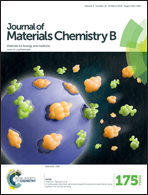Mesoporous nanoparticles Gd2O3@mSiO2/ZnGa2O4:Cr3+,Bi3+ as multifunctional probes for bioimaging†
Abstract
Red/near infrared (NIR) persistent luminescent nanoparticles (PLNPs) hold great potential as a new generation of probes for the detection and imaging of biomolecules. Based upon the consideration that a single nanoprobe could serve multiple purposes, the development of a multimodal nanoprobe that combined the properties of rechargeable persistent emitting luminescence, magnetic resonance imaging (MRI) and drug delivery has attracted our attention as a promising prospect in the field of nanotechnology directed toward biomedical applications. Herein, Gd2O3@mSiO2/ZnGa2O4:Cr3+,Bi3+ (ZGOCB) mesoporous nanoparticles that exhibit enhancement of red (∼695 nm) persistent luminescence (∼18 d) properties were synthesized by using mesoporous silica nanospheres both as morphology-controlling templates and vessels. Being composed of hybrid shell/core architecture and through surface functionalization, Gd2O3@mSiO2/ZGOCB mesoporous nanoparticles possess the capacity for in vivo and in situ real-time monitoring, targeting tumors and drug delivery. Simultaneously, Gd2O3@mSiO2/ZGOCB exhibits a prominent longitudinal relaxivity, indicating that these nanoparticles could also be used as magnetic resonance imaging agents. We believe that this rechargeable red persistent luminescence and MRI-based core/shell structure of the multimodal nanoprobe offers a promising nano-platform for both diagnostics and therapeutics of reactive species in living cells or in vivo.


 Please wait while we load your content...
Please wait while we load your content...